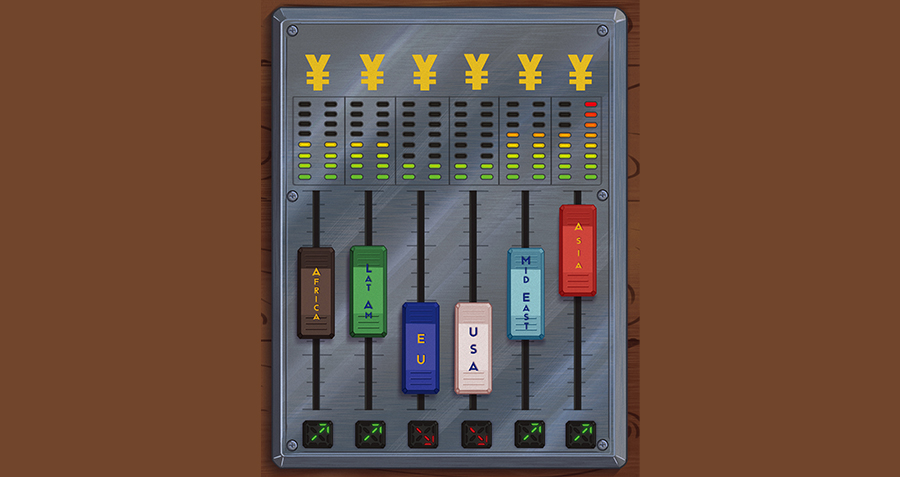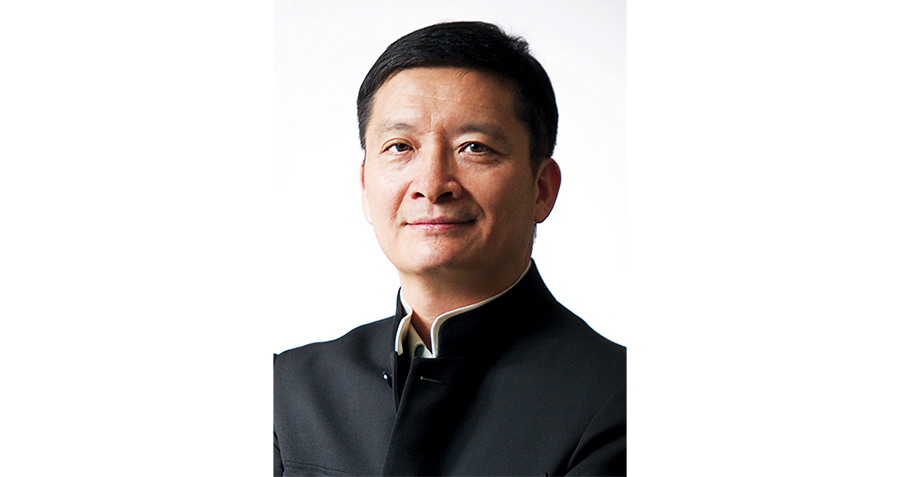Ting Lu, managing director and chief China economist at Japanese investment bank Nomura forecasts China’s economic development
With the People’s Republic of China having just turned 70, there are plenty of reasons to review the impact of the explosive growth of the past few decades and consider what can be expected in the near future. That is the job of Ting Lu, chief China economist at Japanese investment bank Nomura. He joined Nomura in May 2018 from Huatai Securities, where he was chief economist and global head of research. Prior to that, he was head of Greater China economics at Bank of America Merrill Lynch.
As an economist, Lu has been highly ranked in many surveys including No.1 in Institutional Investor’s All-Asia surveys in 2013, 2014 and 2015. While at Huatai, he helped build the research, equity sales and trading teams in Hong Kong, and significantly improved the company’s research and sales teams in mainland China. This contributed to Huatai’s 4th and 5th rankings in the 2017 Institutional Investors All-China Research and Sales Teams surveys, the highest rankings ever achieved by a Chinese securities house.
In this interview, Lu considers the likely trajectory of investment into China, as well as how significant the nation’s debt issue is.
Q: How would you describe the status of China’s economy at present?
Overall, I think that China’s economy can be considered safe. The country is far from a financial crisis or any big economic crisis, but I do believe that a slowdown of economic growth is inevitable, particularly over the next couple of quarters. Sometimes people ask me whether I see it developing into some sort of crisis, but I don’t believe that it will happen. I do think, however, that during the slowdown, we may see more bank defaults as well as other issues.
Q: What would the impact of the gradual slowdown in China’s economic growth be?
Over the next couple of quarters, the slowdown may not in fact be as gradual as many believe. I think it will pick up pace. If that is the case, then I expect growth to slow to below 6% for the rest of this year and as for next year, I expect growth to slow to below 6%.
One major impact of this slowdown will be in employment. More people will struggle to find full-time employment. Over the next year, it will become more difficult for college graduates to find jobs, which could be a big issue, seeing as we currently have over 7 million college graduates being added to the job market each year.
A more serious impact will be on the financial markets. We will likely see stock prices not performing well and, again, an increased number of bank defaults. Exchange rates will also be affected, with a depreciation in RMB exchange rates. We’re currently at around RMB 7.15 to the dollar, which when compared to last year’s RMB 6.3, shows that depreciation is not slow.
As a backdrop to all of this is the US-China trade war, which I believe will escalate even further. It will make China’s exports sector very challenging. It’s likely for us to see a deep contraction of China’s exports within the next 12 months, which is another downward pressure on exchange rate.
Q: What is the likely impact of the US-China trade dispute in the short- to medium-term?
In the short term, the direct impact has been and will continue to be on China’s exports. Exports are very important for the Chinese economy based on its contribution to the country’s Gross Domestic Product (GDP), estimated at around about 13%. An indirect impact of the trade war is if some multinationals decide to move their factories out of China. That’s why over the past year we have seen a slowdown in exports, but we also have observed a slowdown on manufacturing investments, especially for sectors linked to exports.
But we all know that this trade war is not just about trade, it’s also about high tech. Some Chinese companies have been affected, such as Huawei. So in this regard, I think it will be more difficult for Chinese companies, especially high tech companies to attain technology know-how and more sophisticated technology components from the US, which could—in time—improve China’s high-end manufacturing sectors.
Beyond trade and tech, another impact may be a decoupling between the US and China. A decoupling would impact geopolitical relations and have social effects.
Q: How far could a decoupling between the US and China go?
That’s a very good question, but also quite a challenging one to answer at this stage. I certainly hope that decoupling between the two countries doesn’t take place, as it is still possible to prevent decoupling from happening. But given the reality of the current situation, I think that it is more likely than not to happen, but it will be a relatively slow process.
In the best case scenario, both sides will sit down and negotiate with a certain level of good will. Ideally they would be able to find some common ground. I believe that for the US, engagement is still the best strategy and China needs to realize that it is still a middle-income country with a GDP per capita of below $10,000 with still a long way to go to catch up. It still makes sense for China to keep a low profile as there is still a lot to learn from the US and other Western countries. Other than trade, there are also benefits when it comes to learning new tech. There’s a lot to learn, even on topics such as social governance.
But on the part of the US, engagement as an approach makes sense. They should give more time to China and also recognize that China is a country with its own long history, with a population of 1.4 billion. It’s very difficult to run a country of this size.
Q: To what extent do you see China opening up its sectors, including the financial sector, to foreign companies? And what opportunities do you see for foreign companies coming from that?
There are still many opportunities, even now that there is a risk of decoupling. China itself is a very big economy and even if some kind of decoupling were to take place, China may still be able to maintain a growth rate of around 4%-6% over the next few years. After another decade, the size of China’s GDP may be very close to that of the US.
There are also many structural changes taking place in China, such as a rising middle class. Chinese people are still working very hard and still want to do business with other countries across the world. That’s why I believe that there are still a lot of business opportunities in China for foreign firms.
I definitely see China opening up its sectors even further, but of course there will be sectors in which China will still be more conservative. I strongly believe that China welcomes multinational companies, and global banks.
One area that I think will be very difficult for the government to ease its grip on are capital controls. Of course capital inflows will still be welcome, but capital outflows will remain quite difficult. So that’s why for these global financial companies, when they set up shop in China, they need to know the opportunities available to them, but also the limits that will be placed on them. It is likely that they will soon receive the same opportunities as Chinese banks and Chinese brokers, but they will also be placed under the same constraints as Chinese companies when it comes to capital outflows. It’s very difficult to move money out of China.
I truly believe that China will open up to global companies, particularly in sectors such as manufacturing. The financial services sector, however, is much more backwards than manufacturing so that may take longer.
Q: What has the impact of Made in China 2025 been?
We all know that the policy has been criticized, but putting politics aside, for China it’s understandable in its goal to climb up the value ladder. The Chinese government knows that it’s very important to build its own system for protecting IT. So it’s really in the interests of China to do high-level manufacturing on its own. Of course, in the meantime, learning from other countries and importing new technologies are also part of the plan. The development of high-end manufacturing and narrowing the gap between China, Japan, the US and Germany is an important goal in this regard. That is the starting point. I believe that Made in China 2025 is a kind of national strategy, and it’s not just top-down but it’s also bottom-up for Chinese companies to catch up with global players.
And then of course in this process, I believe that given the trade war, China will have to adjust its strategy to put more emphasis on IP protection and R&D. In this process, it’s also extremely important to improve China’s legal system.
I don’t think all of this is happening as a result of US demands, as it really addresses the needs of China. Its aim is to make China a country driven by research and development. I think Chinese people are very smart, hardworking and innovative, so I’m really optimistic about its success, especially if China can really focus on IP protection and increase its investment in R&D.
Q: What do you see as the likely trajectory of ODI and FDI into China in the future?
FDI will be growing, albeit at a slower pace than it was before because of economic uncertainty around the slowing growth rate and trade tensions. I don’t see any significant contraction in FDI in the near future because of all of the investment you can see still coming into the country, such as for Tesla’s new factory to be set up in Shanghai. China is still the world’s largest market for many products and it has a huge consumer base.
ODI on the other hand will be more difficult for two main reasons. The first reason is that for the next few years, it’s likely for China’s current account to reach a deficit. In the past, China accumulated a lot of US dollars in its current account surplus which it could use to make ODI. Going forward, it’s likely that we will start seeing a current account deficit as China’s export growth slows. On the other hand, however, China will have to import a lot of items such as copper, just to maintain domestic consumption and investment. So ODI will be faced with a natural barrier with the current account balance.
The second reason is regarding the same capital controls that I mentioned before. Then, of course, due to a possible decoupling, China is likely to be distanced from the US—possibly even other Western countries as well. In the past, some ODI targeted high-end manufacturing and high-tech companies, but moving forward, the situation around ODI will likely become more sensitive and become more of an issue. I expect in the future that the barrier around ODI will not just be about money, but about whether or not Chinese companies are allowed to make investments of that nature.
Q: People talk about China’s debt issue. How significant is it and how could it manifest itself?
First of all, I do believe that debt has become a real concern, but I find that many observers, economists and investors became worried too early—in around 2010—as they believed that China would collapse. But China didn’t collapse. The economy has grown relatively quickly over the past decade. But now the problem is with a declining current account surplus in the past couple of years. And with the renminbi depreciating, China has actually been accumulating a large amount of foreign debt. This will become a big problem.
In my view, if a country constantly runs a current account surplus to accumulate a large amount of foreign exchange reserves, and if most of the country’s debt is from its own government and corporations and the debt’s denominator is its own currency, then it’s not really such a big issue. Because, in the worst case scenario, it’s always possible for the country’s central bank to print more money to solve the problem.
But now, the real problem is that over the past couple of years, China has rapidly accumulated some foreign debt. In economics we say that when a country runs both a fiscal deficit and a current account deficit—a twin deficit—then we should be more cautious. China is very close to such a situation. We have been running a fiscal deficit for a long time and we will be running a current account deficit very soon.
So the key point here is that the debt itself is not really that big of a problem, but it’s becoming a problem and the problem became bigger and bigger over the past four years, since 2015, because of this accumulation of foreign debt and declining current account surplus.
Q: People talk about a lack of transparency of the China system. To what extent is transparency a problem from your perspective of an economic analyst trying to read China?
First of all, it’s important to say that over the past decade the government has become much more transparent than before. We have many more statistics available and more press conferences are being held. A lot more data has become available to us, such as the data you can find on Chinese government websites.
We now have a lot of associations that collect sector-level data for us and we also have many groups in the private sector that are conducting surveys. So for economists, we have much more data to analyse now than before.
But compared to the quality of statistics that can be found in the US or other advanced economies, there is still a big gap. I of course hope for that gap to be narrowed in the future. The Chinese government could still learn from the practices of advanced economies around the world.

















